OVERVIEW
This pictorial essay will be unlike my essay on castles, —- (Castle thread here) —– whereby I went into details regarding the history of castles, key features of their construction, and the pictures supplied contained narrative about that particular castle. I am neither an architect nor engineer, and I would just wind up copying and pasting a lot of stuff. However, that topic is interesting, and I’ve included a couple awesome videos at the end of the article in the “Resources” section.
Rather, this essay contains my ideas about “church”, as well as thoughts about the meaning of Jesus’ crucifixion. I write from my newfound Deist perspective, which is still in its infancy stage, and quite imperfect. Pictures of churches will serve as a backdrop. The majority of churches shown will be from the Medieval Era — for they are amongst the most glorious architectural structures ever created by mankind.

Wells Cathedral, England, 1175 AD
PREEMPTION OF OBJECTIONS
Preemption #1: Right out of the gate, let me preempt a possible objection from the Religious Right (i.e., religious people who are always right). I KNOW A “CHURCH” IS NOT A BUILDING … technically speaking. The church is “the body of Christ” … wherever two or more are gathered in His name, you got church! OK, are ya happy now?
Preemption #2: I also know that real worship can take place anywhere and in any form. Gorgeous Gothic Cathedrals are not required. The 1895 poem ‘The Prayer of Cyrus Brown’ by Sam Foss, expresses this idea well: ——- “Lasts year I fell in Hidgekin’s well / Headfirst, said Cyrus Brown / With both my heels a -stickin’ up / And my head a-pointin’ down / And I made a prayer right then and there / The best prayer I ever said / The prayingest prayer I ever prayed / A-standin’ on my head.” OK, are ya happy now?
Preemption #3: You won’t like this article if you’re a religion-is-the-opiate-of-the-masses type person, such as this comment I found in my research; –— “Religious architecture and art were to medieval feudalism what advertising and commercialism are to modern capitalism: a rather effective way to build support for the status quo using aesthetics instead of argument. Like the fashion magazine of today, it’s a powerful way to make regular people buy into the system.” This person is not moved by beauty, cynically scoffs at majesty … and, basically, is an idiot. You might want to just look at the pictures.
Preemption #4: The overarching theme behind the pictures and commentary is one of Awe & Majesty. We’ve practically lost these feelings in our culture. Everything is “Awesome, dude!”, but nothing produces Awe. I have less than zero interest in examining the “psychology” behind this. Psychology will only attempt to reason it away. I don’t care about the chemical and electrical impulses that cause my amygdala to produce these emotions. Maslow can take his hierarchy of needs and stick them where the sun don’t shine. Freud can eat a chopped cucumber salad, and contemplate how that symbolizes the demise of the penis. To hell with all of them, I say! The “brain profession” can explain everything …. they just can’t appreciate anything.
I once walked into Canterbury Cathedral (below) in England and my jaw dropped, my heart raced, and my eyes welled up with joy. I don’t need to try to explain it … the mental autopsy would just kill the spirit.

Canterbury Cathedral, England, 1070 AD
MEDITATION
One more thing before we get started. As you read this article you might consider playing the Gregorian Chant music video below (just one static image, so as to not distract). I think it kind of “sets the mood”; to relax the body, calm the soul, and heal the spirit.
=========================================
“God would not approve!! The money should have been given to the poor!!”, is one of the most common objections to these ornate and, yes, very expensive churches. My observation is that such objections are usually raised by non-believers. It’s a sort of attempt to belittle Christians by pointing out their supposed hypocrisy, for surely (they assume) Jesus would have condemned such lavish spending. Of course, holy-roller self-righteous Christians make the same complaint. Both groups must not be aware that some woman named Mary spent one year of wages on an expensive perfume just to wash Jesus’ dirty feet. Judas and the Pharisees made the same “give it to the poor” complaint. Jesus disagreed, saying that what Mary did was a good thing, and besides that, he said …. the poor will be with you always.
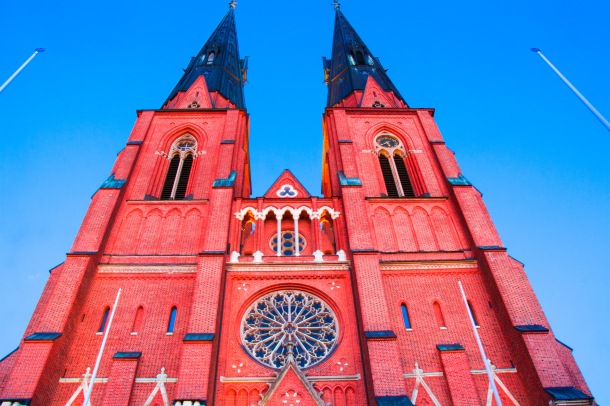
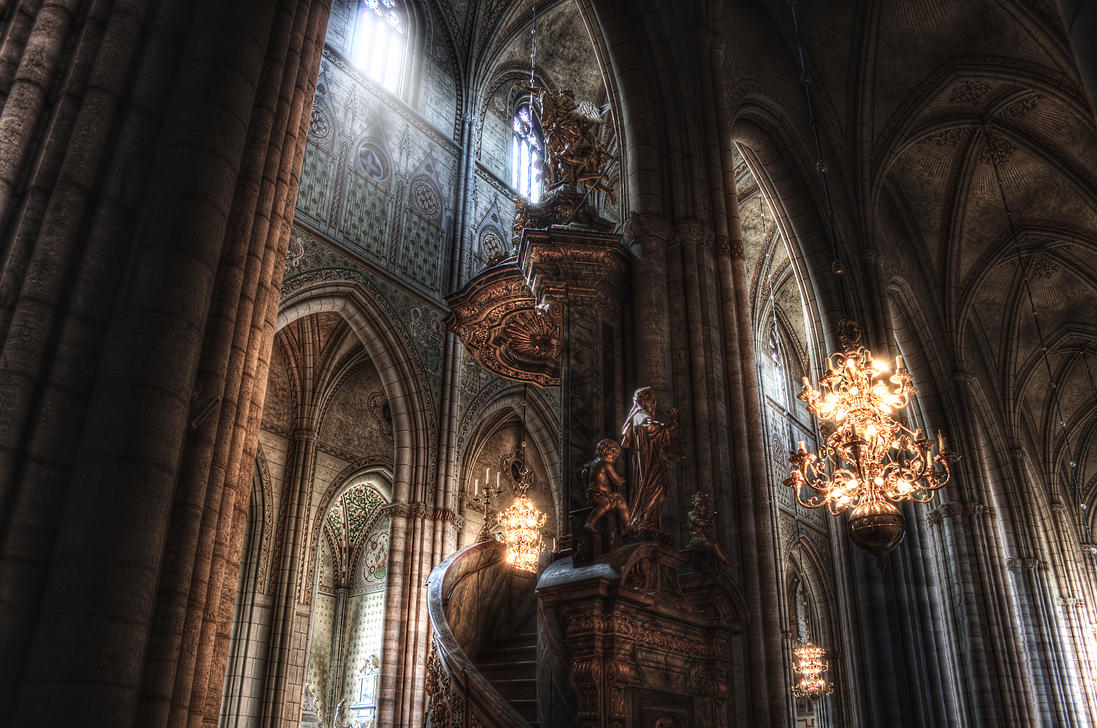
Upsala Cathedral, Sweden, 1272 AD (exterior and interior)
There were various sources of funding these churches. Kings and Bishops often contributed directly from their own funds. Many German churches were funded entirely by the emperor. Churches held annual fairs. Pilgrims donated. Trade guilds donated portions of buildings, for example, stained glass windows. The cathedral at Pisa was built entirely from the spoils of war with the Saracens. And, of course, there was the tithe – the biblical teaching which requires a person to give 10% of their income to God. The medieval church leaders also used less honorable ways to raise money; charging fees for baptisms, weddings, funerals, and Pat Boone concerts.
The most offensive money raising scheme involved the selling of indulgences (a “get out of hell” card). A particular indulgence that funded a significant portion of several churches was ….. butter. That’s right. Cooking with butter during Lent was a sin. But, folks didn’t have an alternative fat for cooking, so they cooked/baked with it anyway. The powers in charge convinced the people that they could buy their way out of God’s punishment for butter eaters. I believe you could avoid boiling in a cauldron of butter in hell for about ten cents per cookie.
I am amazed, even flabbergasted (and I rarely flabbergast) by this; that many humans spare no expense on themselves. We’ll sign on the dotted line and for the next thirty years we’ll slave away to pay off our house – one that almost certainly is too big, too ostentatious, not befitting our actual ability to pay, but meeting our desires, even greed. We have no problem buying a $50,000 car, when one half that price would more than suffice. A hundred dollar bottle of wine for dinner is no problem because, hey, we work hard for our money and deserve to pamper our bruised egos. The best clothes. The best vacations. The best schools. The best doctors. But, when it comes to building a glorious place to worship the Creator then suddenly everyone develops a severe sense of righteousness, a Mr. Scrooge on steroids. And then we applaud ourselves and marvel at our good heartedness.

Ely Cathedral, England, 1091
We go to church and share our most intimate thoughts, desires, hopes, and dreams in the presence of the Creator. We are a sensory people – pleased by beauty, bored with mediocrity, and repulsed by ugliness. Why then can’t people create the very best atmosphere to enhance worship? Should we be deprived of giving the very best of our talents and fruit of our labor … including gold, silver, and breath-taking artistry? I would say there is a need for church to be exponentially different than any other structure we enter.
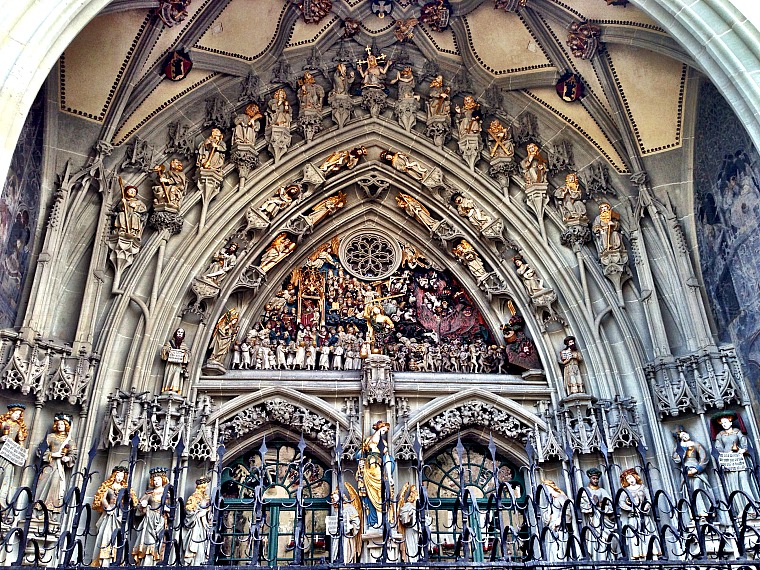
Bern Cathedral entrance (The Final Judgment), Switzerland, 1421 AD
Not too long ago I went to NYC and saw the new One World Trade Center. I did feel a sense of awe, one achieved because of the builders’ brute force and will. It’s beautiful and an undeniably amazing achievement representing the triumph of science and technology. But, like the Dark Tower in Mordor, it’s a cold and forbidding beauty. A mostly featureless shaft of power rising so high into the sky that the people down below become a mere abstraction. How unlike the medieval cathedral … where the soul feels its worth, and the spirit experiences simultaneously the exaltation of God, as well as His distance, and where one can find their intimate and beloved place in the hierarchy of existence.
In its May 2009 issue, Christianity Today reported on a study whereby 1,600 unchurched adults were shown four pictures of church buildings, ranging from mall-like to Gothic. The vast majority preferred the most ornate church, the Gothic one. The human spirit prefers to worship in a place that feels like a church, not an office building.

Evangel Church, Scotch Plains, NJ
I was convinced by a friend to go to this typical modern church (above) last year to watch an inspirational movie. The setting is about as inspiring as a Corporate Office conference room, because it looks like one. It promotes a casual atmosphere …. which is somewhat appropriate as people come to church in jeans, shorts, and even sandals …. cuz, you know, God today is everyone’s “buddy”. Today’s churches are a place for social gathering; they even have coffee houses in them and people bring drinks and snacks into the sanctuary of God – because nothing beats hearing a sermon about God’s glory while munching on a jelly donut. Except for size, this church looks no different than my home (actually, my home is better decorated), and so it promotes a sense of equality with God – “Hey, God’s house ain’t no different than mine!” But, it did give me a sense of awe, as in, “Awe! Get me the heck out of here!!” I’m sorry for what be perceived as a judgmental attitude. I’m just an aging baby-boomer who still remembers the days of his youth when wearing “Sunday’s best” as a show of respect in entering God’s house actually meant something (not that I particularly liked itchy starched shirts and even itchier wool pants!).
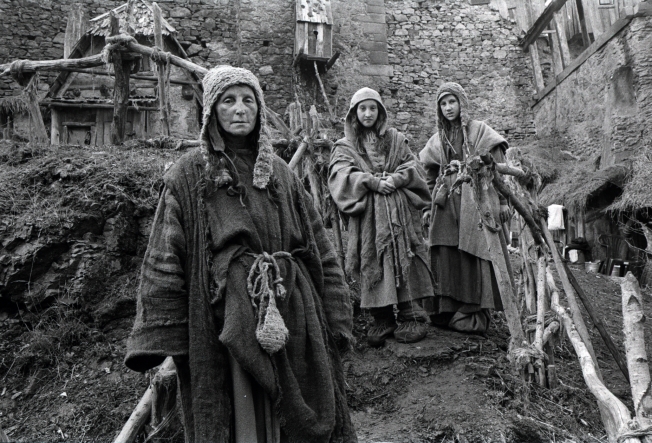
Medieval Life as depicted in the 2013 German movie “Hard To Be A God”
It makes sense to imagine medieval life for the 99% to be a hard and difficult one, rather than the romanticized version we see in movies. Peasants in England lived in cruck houses. These were filthy, usually no more than two rooms, with a wooden frame covered with wattle and daub (a mixture of mud, straw and manure). All manner of bugs and rodents lived in the thatched roof and would fall on you while sleeping. There was shag carpeting …err, I mean, dirt floors. There was no sewage, people just dumped waste out windows, and more often than not, shat in the streets. There was no electricity and the wonderful luxuries that brings; refrigeration, stoves, heat, and light. No music. No entertainment. An extremely limited choice of foods; potatoes, potatoes, or potatoes – depending on where you lived. You worked yourself to the bone, often in tattered rags. There wasn’t even cleanliness in people’s daily lives as people bathed maybe once a week. Life was basically a dreary slog, except when you went to the church.

Sint-Salvator Cathedral, Belgium, 1000AD
In church it was clean. The windows exploded in an amazing kaleidoscope of color. There was music from the organ, an experience not available anywhere else. The seats were comfortable. In church you were a child of God, just like their earthly King. Safety, sound, color, beauty … LIFE! It was as if heaven descended on earth. It was what people lived for. It gave them a glimpse of what the next life might be like, and it gave them hope in this life.
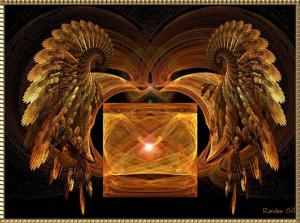
Gold, gold, gold!! Cherubim Guarding The Ark Of The Covenant
King David commissioned his son, Solomon, in 1 Chron. 22:6 to build a temple to God. (That God wanted the temple which Solomon constructed is highly questionable. Let’s leave that argument for another day. Suffice it to say that God did bless the temple as a compromise, and leave it at that.) And what a place of worship it was!! During Solomon’s reign he made “silver to be in Jerusalem as stones”. The Queen of Sheba gave Solomon 120 talents of gold … that’s over seven tons. Jerusalem was awash in gold. Now, granted, when it comes to figures and numbers, the Bible seems to vastly inflate them!
Nevertheless, if we take the Bible at its word, then the construction of the temple included 100,000 talents of gold and 1 million talents of silver! If you haven’t paused and are still reading, go back and read the previous sentence. Back in 1925, the Illinois Society of Architects set out to make estimates of the cost of rebuilding the temple. The cost of the building alone, without the vessels and other furnishings was estimated at $87 BILLION dollars …. in 1925 money. The Iraqi’s …err, Babylonians … eventually destroyed the temple. King Herod built the second temple. It wasn’t nearly as ornate. Nevertheless, construction had gone on for forty-six years by the time of Jesus’ ministry. It required ten thousand laborers according to Josephus, and used much precious material such as gold and marble … and surely cost many tens of millions of dollars (in today’s currency).
Now … there’s a point to the above two paragraphs, and it is this: not once, anywhere, even though he had ample opportunity to do so, did Jesus ever condemn either the need for such an enormously ornate structure, nor the monies needed to construct and maintain it. When asked if it was lawful to pay the temple tax he answered the question, rather than berate the temple. Did he condemn the poor widow who donated the equivalent of a penny towards the upkeep of the temple? Did he lecture what a waste of resources the temple consumed … monies that should have been given to people like this poor widow? No! In, fact, he complimented her. Don’t Christians often ask – “What would Jesus do?” It’s clear he doesn’t speak against worshiping the Almighty in an extremely fancy building, so neither should Christians. Rather than feigning faux outrage at the plight of the poor and the hypocrisy of the rich church, perhaps they should just shut up about it and donate ten percent of their income to a poor person. At least that would be more biblical.

There is a rhyme and reason to the very design of the cathedral, built to bear testimony to the presence of God. Its long nave crossed by the transept before the altar, was in the shape of a cross. The long length of the nave was a reminder of long-suffering, which endures adversity; the breadth was Christian love; and the height was a hope of future reward. The large open spaces filled with sunlight through the stained glass spoke of the glory of the life beyond. . The strong foundations and massive columns and buttresses typified the stability of God’s kingdom. Pictures and ornaments in churches are the lessons of Scripture. In essence, the church itself – the building – was a sermon of Christ, the chief cornerstone … the one which the builders rejected.

Reims Cathedral, France, 1211 AD
Speaking of which, let’s switch gears and look at His life – the object of worship in these magnificent cathedrals. People not interested in spiritual topics, especially regarding Jesus and seeing his message in a new way can stop reading right now. Or, if you are a strictly fundamentalist type Christian, you can go straight to the comments section and do what you do best … condemn me to an eternity in hell
=========================================
There has been a movement afoot for a while, perhaps starting back in the Jesus the Hippie days in the 1960’s, to return to an “original Christianity”. Some want to return to a pre-Constantine church – before religion became an extension of the State. Some want a return to a church before Neo-Platomism – where Greek philosophy perverted the message. And some want to go all the way back to the Apostolic era, before Paul – who they believe reduced Christ’s message to a rules and dogma. It sounds nice, except for one thing — it doesn’t go back far enough.
The great German theologian Dietrich Bonhoeffer in “Letters and papers from prison” wrote that the question one must ask today is whether or not religion is even necessary to participate in the life testified to by Jesus. He envisioned a radically new church with the power to renew and reform which the current liberal, conservative, evangelical, fundamentalist, and orthodox communities could not provide – because they served an impotent God whose main function was to serve our needs, wants, and desires, which he calls “the god of religion”.

Wells Cathedral, England, 1175 AD
I wonder why Christendom prefers a sanitized Jesus. Depictions of the crucified Jesus rarely show much blood; a few trickles from his head and palms, and even less from the gash in his side. His face rarely shows more anguish than one might expect with an abscessed tooth. He never looks horribly terrified – which I believe he was – just that saintly, sad and forlorn face, as if he’s sad for attracting morons like our own Village Idiot. I suppose when God kills God, the horror is too much for us to bear, so we clean it up, wash our hands of his blood, and make it more palpable to the senses.
Skin on the face and skull is thin, and the blood vessels are very close to the surface. Sometimes when I nick myself shaving, that tiny little cut can bleed for half an hour, or more if I remove the small piece of Scotts toilet paper protecting me. So, the crown of thorns, while not fatal, would have been painful and quite bloody. A more accurate portrayal of Jesus’ face would be one completely covered in blood, and his long flowing hair (blond, supposedly) would have been a dark tangled mess of his coagulated dried life force.
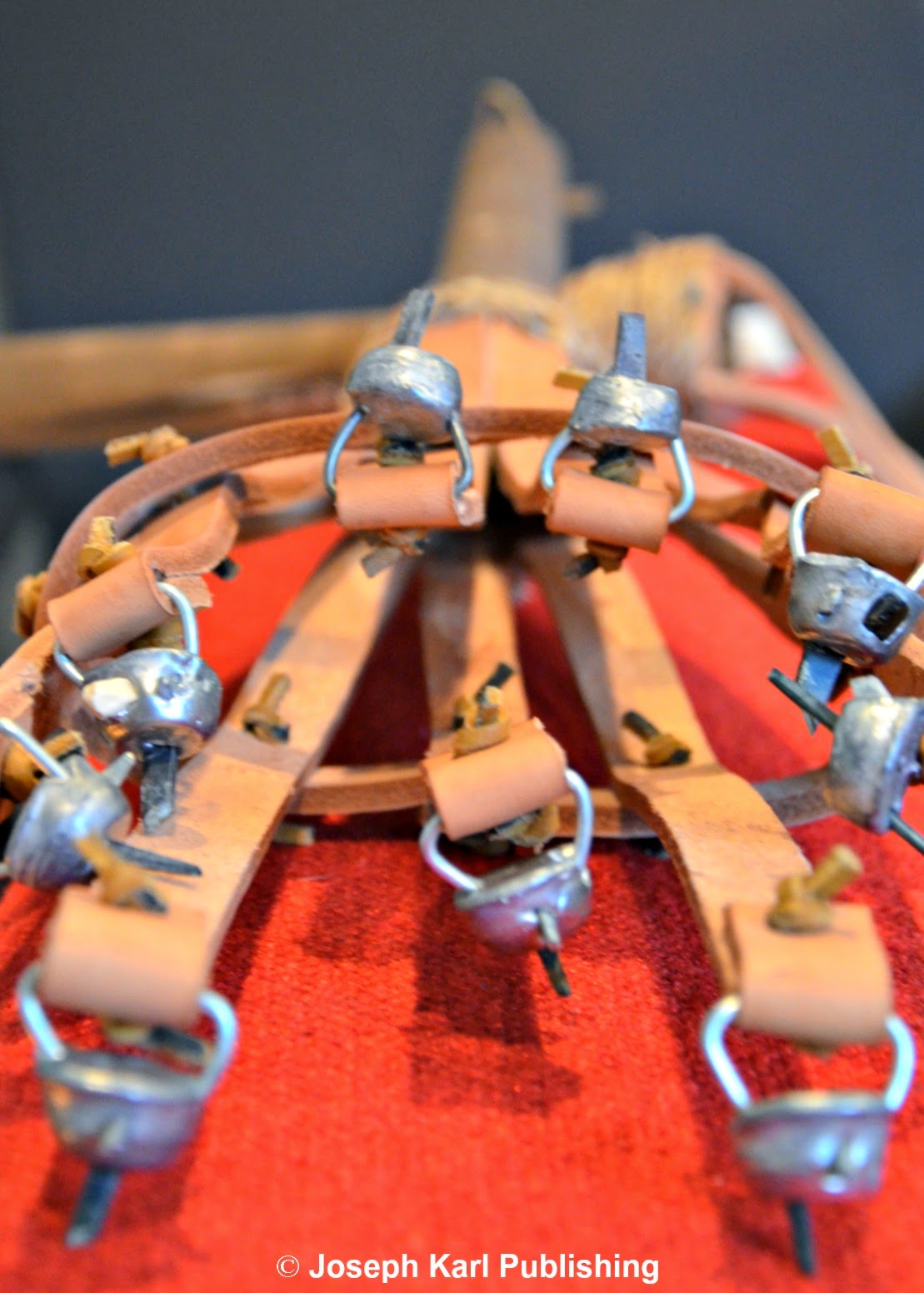 The Roman whip was called a “flagrum”. It was constructed with anywhere from 2 -12 braided leather thongs of variable lengths. At the end were small iron balls and sharp pieces of sheep bones. Some even contained a hook at the end and was given the terrifying name “scorpion.” The flagrum was designed for one purpose; to cause maximum pain by tearing flesh off the body. The Roman soldier would have made Jesus stoop which would make deeper lashes from the shoulders to the waist. Depending on the number of leather thongs, the strength of soldier, and the vigor he employed – all the skin on Jesus’ back could have been gone after just a few whippings to reveal torn flesh, and then eventually exposed muscle, and perhaps even exposed bone … resulting in massive blood loss and shock. When the flogging stopped He was already near death, and for most such prisoners the crucifixion to follow was a blessing.
The Roman whip was called a “flagrum”. It was constructed with anywhere from 2 -12 braided leather thongs of variable lengths. At the end were small iron balls and sharp pieces of sheep bones. Some even contained a hook at the end and was given the terrifying name “scorpion.” The flagrum was designed for one purpose; to cause maximum pain by tearing flesh off the body. The Roman soldier would have made Jesus stoop which would make deeper lashes from the shoulders to the waist. Depending on the number of leather thongs, the strength of soldier, and the vigor he employed – all the skin on Jesus’ back could have been gone after just a few whippings to reveal torn flesh, and then eventually exposed muscle, and perhaps even exposed bone … resulting in massive blood loss and shock. When the flogging stopped He was already near death, and for most such prisoners the crucifixion to follow was a blessing.
The Gospel of John tells us that in this condition Jesus went out “bearing his own cross” all the way to Golgotha, the Place of a Skull. Considering that the crossbeam weighed up to 75 pounds, and was strapped to the prisoner’s back, and his hands tied to it (so that when the prisoner fell, he would literally fall on his face), and the loss of blood, and the shock, not to mentioned that he was beaten with fists even before the flogging, and deprived of food and water, and had some kind of severe medical condition that resulted in the sweating of blood in the Garden of Gethsemane … well, Jesus carrying a cross even for a short while just seems rather unlikely. Not to mention that the other three gospels state the event differently. Mark and Luke indicate Simon of Cyrene was pressed into service after Jesus first carried the cross for a short while, and Matthew indicates Simon carried the cross as soon “as they came out”. Take your pick.

Rouen Cathedral, France, 1202 AD
Now, all this blood and gore stuff has led me to two haunting questions …. and I have never read a satisfactory answer in either case.
First, why is it OK for God to demand a human sacrifice when it is condemned in his own Book? Oh, I understand many ancient religions sacrificed to their blood-thirsty gods; lambs, goats, rams, buffalo, cows, horses, chickens, birds, and probably other animal flesh. I also understand that the Top 10 human sacrifice civilizations were; Canaanites, Aztecs, Etruscans, Celts, Romans, Minoans, Gauls, Carthaginians, Scythians, and Chimu. I also understand that Abraham was about to slit his own son’s throat, until Yahweh stopped him at the very last moment. Yet, thousands of years later Yahweh looks the other way when His Son is sacrificed … yeah, he even demands it.
I understand the complex theology that attempts to explain it. Hold on to your britches, folks, and try to follow along; — 1) all people have sinned against God 2) but, God is infinitely holy and righteous 3) so, he must punish the law-breaker, 4) if he didn’t there would be no Law, for there is no law that is a law without a punishment, 5) and the punishment for breaking the Law is separation from God 6) so, we law-breakers need a way to escape the righteous judgment of God, 7) but we law-breakers are stained by sin and can’t save ourselves, 8) which means only God can save us, 9) so Jesus came, God in the flesh, 10) but, even He, as a human, was under the Law, 11) so, that meant he had to die, 12) but, he was perfect, i.e., without sin, 12) so, his sinless life and perfect sacrifice fulfilled the requirements of the Law, — which states that only blood makes atonement for one’s life for without the shedding of blood there is no forgiveness 13) so, killing Jesus was an act of love on God’s behalf because we are now forgiven, 14) and all this still isn’t good enough to get you into heaven …. you have to believe it, 15) and if you don’t, you’re going straight to hell!!
Are you still with me? There is no less brutal way! God can only achieve what God wants through suffering, they say. And quite frankly, I still don’t understand this Theology of Blood.

St Stephen’s Cathedral, Austria, 1147AD
Which brings me to the second question, why is torture part of the equation? Did the temple priest first torture bulls and goats before they slit their throats? Of course, not. Would Jesus’ death have been in vain if the Romans just lopped off his head? Pointing out that Jesus’ suffering was a fulfillment of Old Testament prophecies only begs the question further; why does torture please God? And if it does, why make it so brief? Why not have a week-long torture fest?
One of the most common reasons given is that is shows exactly how much God hates sin, that God even allows his only begotten son to die so painfully. It’s an object lesson for stupid humans. Another popular reason is it shows exactly how much mankind hates God – man, the God-killer. Theocide. Another object lesson. Do these reasons satisfy? Do they even make sense? Why do people believe whatever reasons the imagination can supply? Perhaps it is a desperate attempt to explain the unexplainable ….
Or, perhaps people are easily convinced because we want certainty. People have a deep-seated desire for an ordered universe, a universe that makes sense, a universe where we are special snowflakes and valued, a universe created by a God who is not irrational. So, God killing God becomes an act of love!
On top of it all, we want to convince ourselves that we believe for reasons other than psychological need. How many trillions of times has this prayer been uttered — “Lord, give me more faith”. A doubting Thomas is rarely admired. And, so, pulpits across the land are filled with pastors who are 100% confident about … everything, including why God had to kill God. Getting people to believe is actually fairly easy because believing and following is so natural for most humans. And pretty soon the flock in the pew believes everything the pastor believes. It wasn’t Jesus that was nailed to the cross .. it was their doubt.

Milan Cathedral, Italy, rooftop view, 1386
But, is this a statement of faith– “My God, my God, why have you forsaken me?” or, is it a cry of utter doubt? No, not the doubt that arises from some rational reflection upon an absence of divinity, but rather one that wells up from the trauma of personally experiencing that absence. Here, at last, is the heart of Christianity, God despairs of God.
In response, the faithful come up with a narrative that brings meaning, order, and stability to this horribly fragmented experience … the unexplainable demands a myth, or explanation. As such, the central scandalous horror of the Cross is stripped away whereby truth is domesticated by barely acknowledging Jesus’ sense of divine terror while robbing it of its trauma. The Cross becomes a means to offering ultimate security – “Jesus died for ME!!”. Rather than the Cross being a place where literally all meaning is ripped away, doubt, unknowing, and loss is eclipsed by an even greater certainty that everything is just fine.
The faithful seem to have forgotten (if the majority even knew in the first place) that the Cross signals an experience in which everything that grounds them and gives meaning collapses. A 4th Turning event for Christendom. On the cross, Jesus is rejected by his friends, abandoned by most of his family, betrayed by religious authorities, crucified by political leaders, and despised by God. In other words, Jesus witnessed the loss of every structure which gives comfort and meaning to life. More than this, Jesus experiences a loss which grounds each of these realms …. God, himself. A populist view of Jesus’ sacrifice on the cross is that he lost everything for us and for God, when the truth of the matter is he lost everything … including God.

Cathedral of Saint Basil the Blessed, Russia, 1555AD
Now might be a good time to ask; “What is modern American Christianity’s response to the Cross, where Jesus lost everything?” Sadly, it reduces the meaning of the crucifixion to giving mere intellectual ascent to a historical event. The cry at the Cross is just a minor signpost to something that happened a long time ago. You have the Village Idiot screaming at you incessantly — “Jesus died for your sins!! Just belieeeeeve!!” – (alas, accompanied with fire and brimstone and eternity in hell in case you don’t believe their message) — in hopes that one day you will relent with an “OK, I believe”, for that is all it takes, they say, to insure your place in heaven forever. A dumbed-down religion for the masses that insures many millions can enter into eternity with no more effort than uttering a couple magic words.
Instead of trying to silence the true horror of Christ’s cry of dereliction, a true Christianity (imho) is one that embraces it and enters into it. God’s absence at the Cross does not necessarily negate his presence. If being a Christian involves participating in the crucifixion, then it ought to mean that we also undergo Christ’s earth shattering loss. Paradoxically, then, experiencing the absence of God is the fundamental way of entering into the very presence of God.
It seems to me that only when one is crushed by a deep, existential loss of certainty, that one finds oneself “in Christ”. That moment when we feel the loss of ALL that once gave us meaning – including your religion — is the very moment that we stand side by side with Christ. This is what Bonhoeffer meant by Christianity without religion. The bottom line is this; Christianity is not merely affirming or contemplating the death of Jesus on the cross …. it is to undergo that death in our own lives.
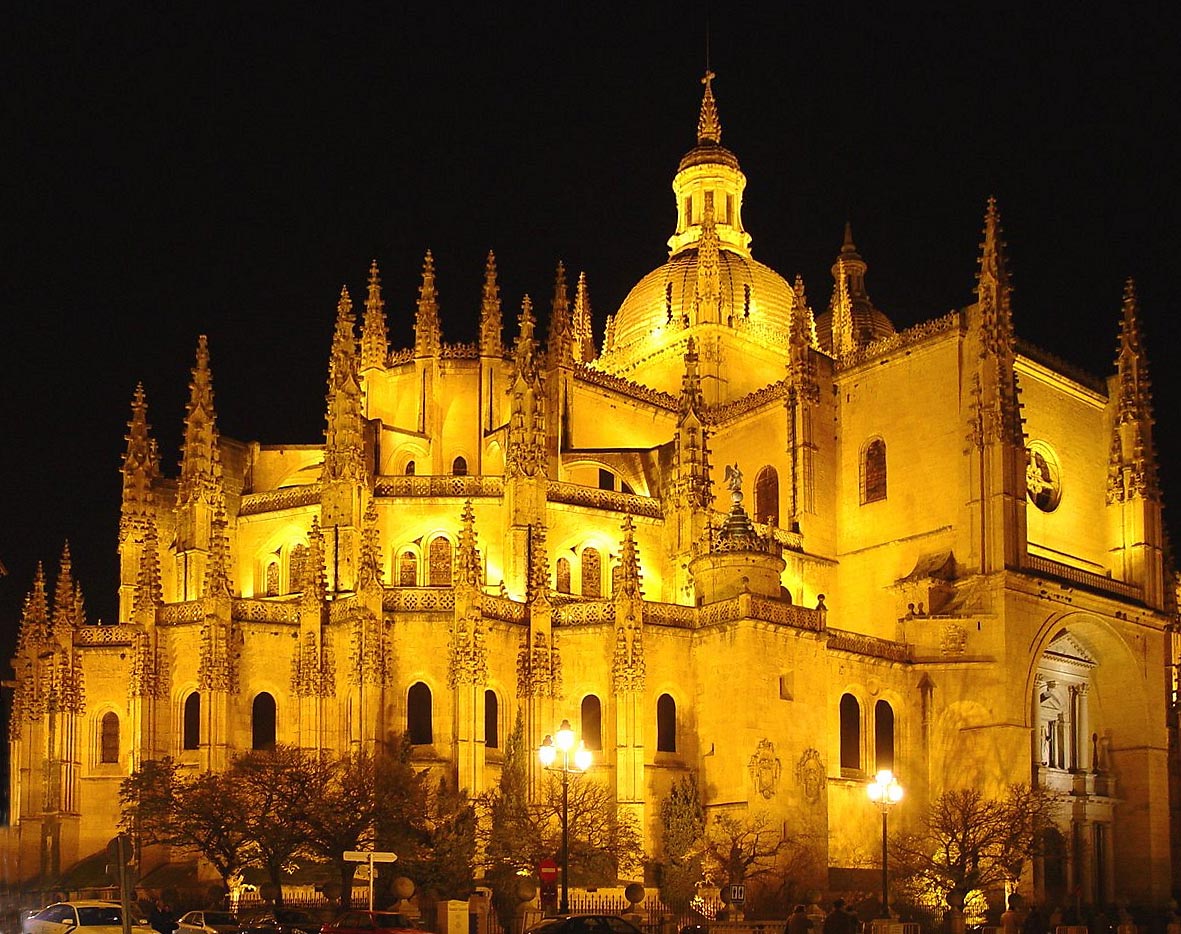
Seville Cathedral, Spain, 1401 (largest Gothic cathedral in the world)
And that is a terrifying process!! You might walk to the altar to the tune of “Just As I Am”, but for far too many it ends there. Death to ourselves ought to involve dramatic changes. It would almost certainly involve cutting ourselves off from the system we constructed, and which constructed us. How many can do this? I tried. I failed. Give me one hundred Christians, and ninety-nine prefer to stand next to the Risen Christ at the grave, and only 1% at the Cross. Crosses demand death. Resurrections allow you to be “just as I am” forever, and without consequence.
And, as such, millions upon millions of Christians every week happily attend church – the institute that treats God as a cow on our behalf, and a place that protects us from experiencing the death at the cross. The worship songs only affirm certainty …. one must never celebrate uncertainty. Sermons lay bare all mysteries and always speak of absolute conviction about everything … doubts are a sign of spiritual weakness. Our prayers never question God or accuse Him … for cynicism is akin to blasphemy against God according to the Village Idiots. Church is where congregants can speak passionately about the “dark night of the soul” … without ever experiencing it.

Amiens Cathedral, France, 1220AD
Yet, the Holy People in my life — including immediate family members — condemn me for not wanting any part of the religious church. They don’t understand that I have zero interest in this structure, church as a great big security blanket, which does all the thinking for me, and who condemns and isolates and cries “heretic!” at those who dare think for themselves.
Holy People and Village Idiots, when cornered, will admit that their prognostications of hate, venom, and condemnation is best left to God, and might even admit their practices fall short of their beliefs. “We’re not yet perfect in this world!”, they cry out. What a load of crap! Fact is, their practices are their beliefs, a true reflection of their soul. That’s because the outer-world is not something that needs to be brought into line with our inner-world but, rather, it is a reflection of it. If you have such people in your life, if possible, run from them as fast as you can, for they will do nothing but drag you into their own personal hell-on-earth.
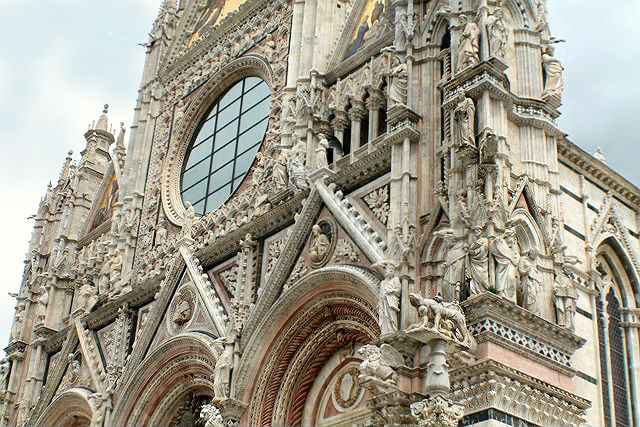
Sienna Cathedral, Italy, 1196AD
I am about to bring this story to a close. Conspicuously, I have left out the Resurrection. There’s a reason for that; because that story is about a miracle and requires faith, and this article is not about that. Up until this point, everything written about Jesus and his crucifixion did happen, or could have happened, without reliance upon the supernatural. Jesus was born, he lived for about 33 years, and then he was killed on a cross … historically verifiable, no miracles needed. The crucifixion takes place in this world, while the resurrection is other-worldly. The topic is worthy of a separate writing, however, let me close with a controversial observation.
The first mention of the resurrection occurs in Paul’s epistles … which were written before the gospels. Yet, Paul is virtually silent about the teachings and miracles ascribed to Jesus. No virgin birth, no Sermon on the Mount, no feeding the five thousand, no public ministry, no cleansing the temple, no final words, and no Great Commission. No parables of the sheep and the goats, or the prodigal son, or the rich man and Lazarus, or the lost sheep, or the good Samaritan. As far as Paul is concerned, Jesus wasn’t a teacher. No driving out evil spirits, or healing the invalid at Bethesda, or cleansing the lepers, or raising Lazarus, or other healing miracles. As far as Paul is concerned, Jesus performed no miracles at all. Paul doesn’t even place Jesus within history—there’s nothing to connect Jesus with historical figures like Caesar Augustus, King Herod, or Pontius Pilate. Really, it’s as if Paul didn’t know Jesus at all.
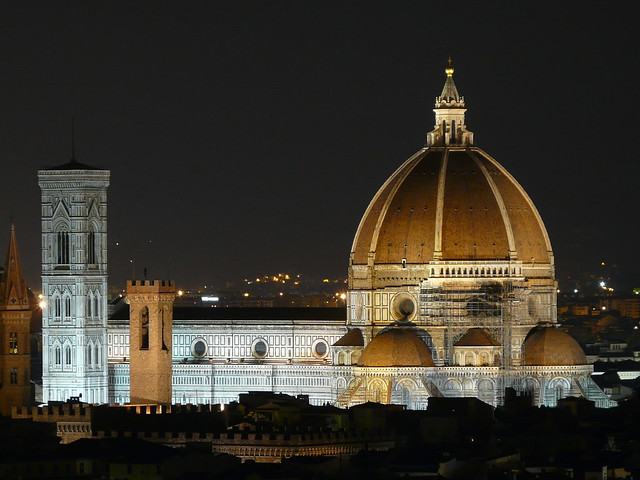
(Gothic elegance) Basilica di Santa Maria del Fiore, Italy, 1296 AD
On the other hand, Paul did have access to the disciples who knew Jesus firsthand. It is possible, perhaps even likely, that Paul did know at least some of the things above. Which makes the situation even worse because it is then crystal clear that all these aspects of Jesus’ life were of no interest to Paul. Paul’s interest in Jesus can be summed up in this passage from 1 Corinthians 15 — “For what I received I passed on to you as of first importance: that Christ died for our sins according to the Scriptures, that he was buried, that he was raised on the third day according to the Scriptures …” …. the theology of Paul in one sentence.
For Paul, adherence to a set of Jesus’ teachings and belief in his miracles meant absolutely nothing. Paul’s “Jesus formula” can be reduced to three steps; 1) Crucifixion, 2) Resurrection, and 3) Conversion. Nothing else mattered. Of course, this was a radical departure from the Jewish faith — of which “Christianity” was still a sect before Paul’s arrival. It is in that sense that Paul , not Jesus, founded a new religion.
Naturally, Paul added some “muscle” to his new message in terms of threats and condemnations … a conversion technque followed by Village Idiots forever after. Paul said that those who do not believe in the resurrection are pitiful, and that their faith is in vain. I think he’s full of **it. Let me use this ancient Buddhist parable to explain why.

Santa María del Mar, Spain, 1329AD
A story: There was once a young mother whose only child died in infancy. The woman was so distraught that she wrapped the infant’s body in cloth and searched for someone who would able to resuscitate him. She traveled throughout the land to see doctors, magicians, and priests, but none could help her. One day she heard of a Holy Man who lived high up in the mountains and who possessed great powers. Upon finding him she related her story through many tears. When she had finished the Holy Man thought for a moment, and then said to her with great compassion; “I can help you. But, in order for me to offer the appropriate prayer, you must bring to me a handful of mustard seeds from the home of someone who has not suffered the pain of loss.” Delighted, the young mother left immediately and traveled throughout the land in search of a home that had not been overshadowed with pain. She searched for a year, but could not find a single such home. Instead, she heard many stories of others suffering great loss. Slowly she came to terms with her own suffering, until one day she was able to give her beloved son a proper burial.
This woman suffered so much that she seeks to avoid reality by any means necessary. Meanwhile, the Holy Man realized the child is dead and nothing will bring him back. It is interesting to note what the Holy Man does not do. He does not say to her that nothing can be done, and then send her on her way. He does not offer empty platitudes about the tragedy of life. But, best of all he does not use the opportunity to introduce the crutch of religion – “Your son is in a better place!”.
What he does realize is that this woman needs to face her pain, and work through it. His advice is meant to bring the woman into contact with others who have also suffered, who are able to understand her pain through a shared experience, and connect with her on a human level. The woman wanted instant relief. What she needed, the Holy Man knew, was human contact with those who could connect with her dark night of the soul in all its horror and distress. She didn’t need a system of explanations, a magic formula, talk of heaven, or even a miracle. She needed deep, honest, and compassionate human interaction. Like Jesus on the cross, to be truly set free she didn’t need to escape suffering, she needed to embrace it.
In my life, if possible, I want to be that Holy Man for those who cross my path, offering true wisdom. In my life, if possible, I want to be a part of that holy community who can offer comfort when 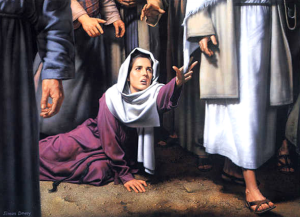 needed, because I have been comforted. In that way, historical event or not, I live the resurrection of Christ. And that’s enough for me.
needed, because I have been comforted. In that way, historical event or not, I live the resurrection of Christ. And that’s enough for me.
Peace to all of you … especially to those whom I’ve offended with this article, including Village Idiots on internet forums throughout the land.
===========================================
RESOURCES — VISUAL
https://www.youtube.com/watch?feature=player_detailpage&v=Lq1UXNjA3gQ
RESOURCES — BOOKS and TEXT
Book: “The Cube And The Cathedral” –— A short book that examines, among other things, the connection between spirituality and architecture. The author foresees the end of Western civilization if the cube (below) triumphs over the cathedral.
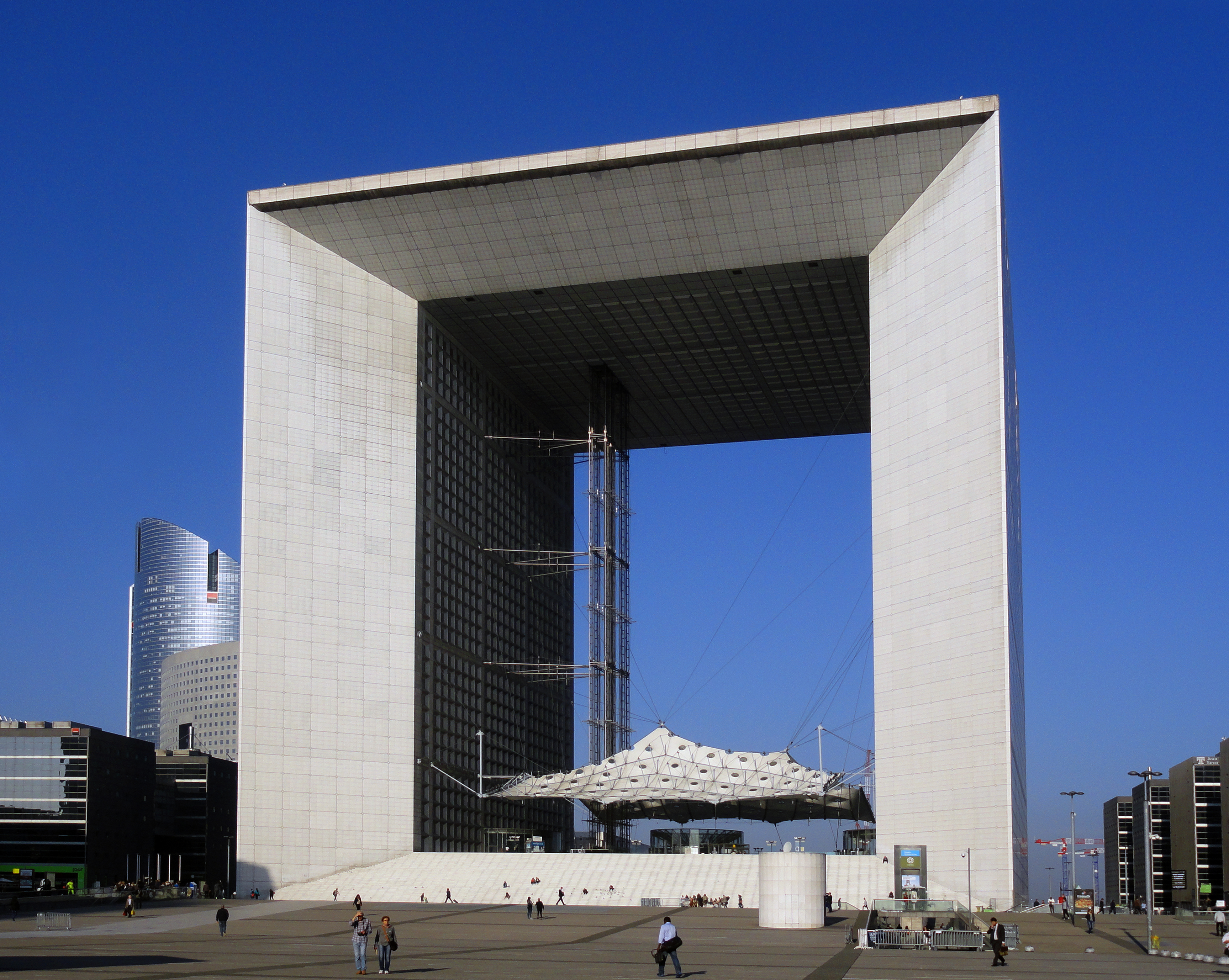
http://www.amazon.com/gp/product/0465092667?tag=beliefnetauto-20
Book: “Belief and Unbelief in Medieval Europe” — http://www.amazon.com/Belief-Unbelief-Medieval-Europe-Arnold/dp/0340807865
Text: “The 8th Wonder Of The Ancient World: Solomon’s Temple” — http://www.creationconcepts.org/resources/SOLOMON.pdf
SACRED GEOMETRY: The strands of our DNA, the cornea of our eye, snow flakes, pine cones, flower petals, diamond crystals, the branching of trees, a nautilus shell, the star we spin around, the galaxy we spiral within, the air we breathe, and all life forms as we know them emerge out of timeless geometric codes. Sacred geometry is the belief that God created the universe according to a geometric plan. It is also the geometry used in the design and construction of many religious structures; churches, temples, mosques, religious monuments, altars, tabernacles, sacred groves, village greens and in the creation of religious art. It is a fascinating topic to study, especially for the math oriented folks.
Sacred Geometry Website: http://sacredgeometryinternational.com/the-meaning-of-sacred-geometry
Sacred Geometry Video: “Sacred Geometry Taught In A Donald Duck Cartoon”: https://www.youtube.com/watch?v=kVTPwPh7ioU




Just moments ago a soccer game ended.
The USA national team vs Germany … you know, the last WORLD CUP WINNERS … the number 1 ranked team in the WORLD …. and the game was IN Germany ……….. and the USA!USA!USA! …. WON!!!!!! (2-1)
We’re Number 1 !!
We’re Number 1 !!
We’re Number 1 !!
I believe in Jehovah, Jesus, Buddha, Zoro A, Mo, Thor, and Obama (for this occurred under his Administration).
Oh .. and today, for the next 15 minutes, I love EVERYBODY ….. even bb.
USA!USA!USA!
(Nice way to hijack a thread, eh?)
Great work, Stucky. My wife is thrilled since she’s a sucker for cathedrals.
Stuck
I’ve sent the link to all the websites that post TBP articles. I’m sure it will get wide distribution.
Well done, Stuck!
A great read. I hope to offer some more thoughts on this when I have a little more time.
Again, well done.
Stucky,
I will have to read/watch when I get home. Looks great. If I may recommend a book Ken Follett’s “Pillars of the Earth” is a wonderful read of cathedral construction in early England I think around the 12th century. Great story telling. It’s sequel “World Without End” is equally readable. Thanks again Sir Stucky.
Bob.
Simply beautiful , good job Stucky. You do have your moments .
Wow, that’s a rambing read right there. The end is the best part, after scratching my head over the story of the woman with the dead child, the paragraph following (in my life, if possible) is beautiful and concise. Maybe I have a little deist in me I wasn’t aware of. Nice essay
Looks great Stuck! I’ll be reading tonight from work. I used to live right down the road from Ely Cathedral. Ely Cathedral is depicted on the from cover of Pink Floyds Division Bell. Two of my favs in Espana were Toledo and Segovia but it’s hard to have a favorite when there are so many to choose from. Salisbury Cathedral in the UK with the tallest spire in Europe is magnificent as well. We are preparing to have a yard sale and I’ll be selling a piece of stone taken from Salisbury Cathedral during renovations which just recently concluded.
These places are magnificent and the history they harbor is vast. Even cathedral ruins are magnificent!
Part way through. Like it so far. One quibble: indulgences aren’t a “get out of hell card”. They’re a “get out of purgatory card”. Purgatory is like heaven’s anteroom , where the vestigial attachment to sin is washed off. Once purgatory’s done serving that function, it will cease to exist. Church-approved indulgences had/have so many caveats (mostly regarding the mindset) that they didn’t really promise much of anything.
Thanks for the wonderful post, Stucky. You don’t have to be a “Christian” to appreciate the dazzling beauty of these places, or the kind of architectural and engineering genius that built them…. or the sheer love that motivated the people who contributed to getting them built. Just standing in one of these places is spiritually uplifting.
I can’t help but think of the (un)aesthetic opinions of that strange bird, Ayn Rand, who wrote a great deal about the metaphysical expression of art- what the preference for a particular style or school said about a person. Rand hated Gothic architecture, in particular, regarding it as dehumanizing, designed to reduce humans and make them feel small and humble. I disagree. I feel that this architecture was inspired by the same spiritual craving that drove the moderns to erect 100 story Deco skyscrapers in the 20th, whose forms and embellishment take so much from Gothic cathedrals (and Mayan temples). It is, like the Mayan style and the great early 20th century buildings, expressive of a spiritual craving for achievement and for transcendence of earthly constraints. It does not crush the human spirit, but elevates it, makes it more human.
gasp, gasp … I’ll be gone shortly folks ……. heart attack ……. need to call 911 ASAP ……….. bb complimented me ……
Wow. I figured he, of all people, would ream me a new one. I figured wrong. You forced my hand you little turd!! … soooo, thanks very much. You may resume flinging shit at this time.
Bostonbob … thanks much for the “Pillars of the earth” suggestion …. I’ve heard ot it, never knew what it was about …. I read very very few novels, but that looks like it’ll be the exception.
starfcker … no need to ever scratch your head again …. I ALWAYS tie everything together 🙂
Chicago999444 …. intellectually I can understand Ayn Rand’s point about churches making us feel “small” ….. but, not on a practical level for I, myself, have never felt that way … and I’ve seen a lot of gorgeous churches over a lot of years ……….. conversely then, would she say going into a one room dilapidated church makes one feel “big” … and I can also assure that is NOT the case …
To all …. thanks.
I_S …. I know you’re an astronomy guy …. the only thing that produces in me the same kind of Awe and appreciation is looking into the heavens … seeing a gazillion billion stars (or so it seems) in the high desert …. and I told you this once before, a guy let me look through his telescope and I saw, with my own two eyes, the rings of Saturn ……… so very cool.
Holy shit Stucky, that was fantastic (and I liked the pictures of the cathedrals, too). Thanks for making me think.
Thanks, Araven. Someone said that I destroy minds with my heretic writings. I hope that doesn’t happen to you as you think!
Stucky says:
Bostonbob … thanks much for the “Pillars of the earth” suggestion
____________________________________
It’s a wonderful book, Stuck. You should love it. It also now has two sequels.
I see there’s also an 8-part POTE mini-series …. rottentomatoes gives it 86% – 94%
Follett is an author of WW2 spy novels (Eye of the Needle). From what I remember he moved to a town in rural England and became enamored with the local cathedral, which provided the motivation to study the period.
Glorious buildings and built by hand 1000 years ago. They would not be equaled by man until 100 years ago when the Captains of industry armed with steel and electricity could build new Cathedrals to the Gods of Commerce and Progress.
Lobby of the Woolworth Building 1913
Cupola of the Woolworth Building 792 above the street ( for sale too if you’ve got $100 million)
I don’t know if I should sob or get up and give you a standing O………..that was really something. Beautiful pictures, nothing said we have all the money/power/armies like castles and cathedrals back in the day when the peasants blindly went along with the programming.
Deists don’t need no churches or trappings of organized religion.
Stucky says: Thanks, Araven. Someone said that I destroy minds with my heretic writings.
I think the person said ‘blasphemous’ in reference to a God impostor.
1. The rich woman poured perfume on His head, another ot the same one washed his feet with her tears.
2. The life is in the blood, according to the bible, and biology says everything visible of our person is dead cells, therefore, to be covered with the blood is to be covered with life. God is a god of the living, according to the bible.
3. The bible says that thru his welts, we are healed. And through his blood we are cleansed. It all makes sense if you think about it.
4. Paul was not part of the followers of Jesus, he had persecuted them. His revelation came after the visitation. He tied the old testament together with the new. He didn’t invent the gospel of diety of Christ, he provided the interpretation of old testament prophesy.
5. Peter says the bible is not something that is to be interpreted, granted, but non-believers have a veil over their eyes and can’t see what is plainly in front of them. Paul’s conversion and scales falling from his sight is the necessary step in a true conversion.
6. I have more to say but I will wait for you to grant me an opportunity next time.
Cain. Seems very amazing what can be done when the “soil” is worked. But it is all “soil” and “painful
toil”, with “cursed” ground….”fruits of the soil”. It will need buttressing until the end of time. What we so desperately need we all know are the “fruits of the Spirit”. But those fruits only come when we observe “sabbath”, rest from our own works, and “enter his rest”. Do we take, do all take, is it possible to take these beautiful works to represent Christ’s work, His righteousness imparted to us…rather than our righteous works which though most beautiful in our own eyes, are contemptible and even evil in His? Herein lies the age old difference between what Cain brought and what witnessed of Abel’s faith.
Having lost a child, we can testify that comfort comes not in realizing the sorrow of others…that “in Adam all die”, but rather with the hope that “in Christ all will be made alive”…that because of His death we can live and one day “will be caught up together with them in the clouds to meet the Lord in the air. And so we will be with the Lord forever.”
they won’t come to the light because their works are evil
Congratulations on the visual and informative piece. A good follow up to the best and worst car series of earlier.
As a quick follow up, I just looked up the exact definition of deism. I really don’t see how that definition of “God” is all that differet if at all than what most of Chritianity believes. It was ” belief in a supreme being who does not interfere in earthly day to day matters”. If you have time do explain how “deism” is unique,the same, or what draws you to it. Religion, although personal, is fascinating.
Thanks Stuck. I have seen a lot of those in person.
At this stage, my position is, after seeing 12,351 cathedrals, if I never see another it will be too soon. However, my all-time favorite is not medieval, but a modern masterpiece. Gaudi’s Sagrada Familia:
[img [/img]
[/img]
[img]http://t2.gstatic.com/images?q=tbn:ANd9GcSJhvfMEjJlhnErfHc4vz5ULJ_ApvWPsVU01TgKAdB90YA0jj5x[/img]
[img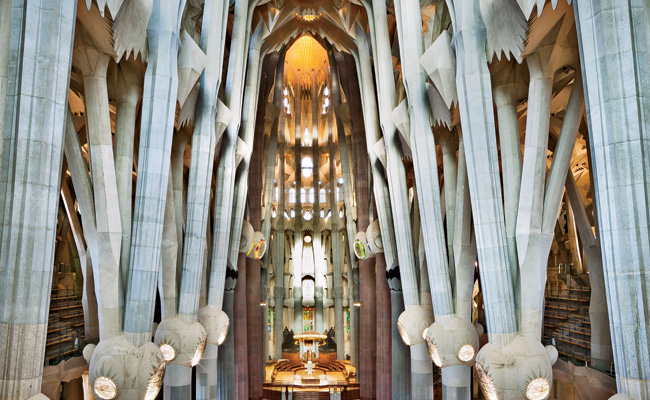 [/img]
[/img]
[img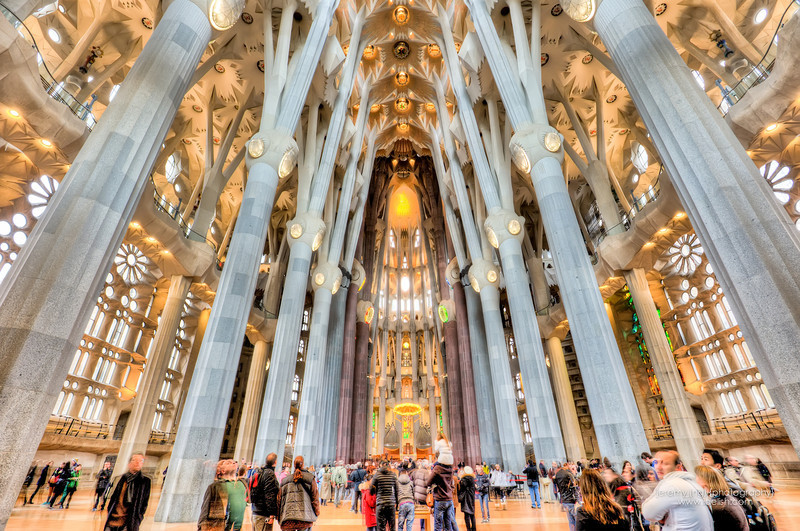 [/img]
[/img]
Re the Florence Cathedral, you give a date of 1296, when it was commenced.
However, that is a somewhat incomplete annotation, given the cathedral was not completed until 1436, and its major attributes, especially the magnificent duomo, was the work of Fillipo Brunelleschi. The duomo is something truly remarkable, and it boggles the mind how someone could have built it at that time. IT is a wondrous thing, and a singularly incredible piece of engineering and art.
It is, in my opinion, a Renaissance cathedral, although it commenced as a Gothic, and not a true medieval cathedral, owing to that magnificent duomo. It is an incredible structure, and my favorite of the “old” cathedrals. It is especially striking given all of the Renaissance works that surround it.
Good gawd llpoh can’t yew just let him bask in the limelight without yer pointy little red head needin ter set sumthin straight.
Llpoh
All the dates given are “best-estimate” START of construction. Some churches took 500+ years in the form they are today. So, saying 1856AD, for example, would give the impression it wasn’t built during the Gothic era. Even so, some (or, many) of the start dates are not-really start dates. For example, many churches were destroyed by fire, war, or other natural disaster … maybe the foundation was left, or even half the church, or whatever. So, a church listed as a start date of 1200 … might actually have been started in 900. Last but not least, there is much disagreement over these dates …. one site might say commencement started in 1100, another says 1200, and so forth. In short — look at the dates as an approximation only.
Regarding the Sagrada Familia … the exterior seems much to gaudy for my tastes ….. but the interior? …. SPECTACULAR!!!!!
“Deists don’t need no churches or trappings of organized religion.” ——– Bea Lever
You might be right. But, we can enjoy and appreciate them … as in the manner Chicago999444 @6:37 explains. Right?
“If you have time do explain how “deism” is unique,the same, or what draws you to it. ” —- Jim
Thanks for asking. I would love to do so ……… tomorrow. It’s 10:10PM and if I don’t get my fat ass to bed in the next couple minutes, I’ll probably wake up tomorrow as a eunuch.
G’ Night Mates!!
Stucky,
Wonderful!
Two thumbs up, a big smile as well, and a pat on the back if my arm were long enough to stretch from way out here to way back there.
“I once walked into Canterbury Cathedral (below) in England and my jaw dropped, my heart raced, and my eyes welled up with joy. I don’t need to try to explain it … the mental autopsy would just kill the spirit.”
Beautiful post, beautiful words. Thank you.
Love the essay Stucky.
One quibble, since it’s in my nature. You said: “Peasants in England lived in cruck houses. … An extremely limited choice of foods; potatoes, potatoes, or potatoes – depending on where you lived.”
I think you were referring to the medieval period. Potatoes are a new world food and weren’t introduced to Europe until the 16th Century.
http://en.wikipedia.org/wiki/Potato#History
P – great catch! A TBP classic!
Stucky – you gotta admit, that is hilarious!
The basic plan for the medieval cathedral was the Roman Basilica, which was a secular government building. The best example is the Basilica Nova, which stood intact for centuries, perhaps destroyed by earthquakes or by another account slowly after a pope had its bronze roof removed.
http://en.wikipedia.org/wiki/Basilica_of_Maxentius
I’m trying my best to come up with a comment that will be critical of this article and ruin your day, Stucky. Been thinking about it for hours. Nothing. Blank screen.
You are an excellent, interesting, and compelling writer. So-o-o, well done.
Stucky says:
King Herod built the second temple.
_______________________
Wrong. Cyrus, King of Persia built the second temple, although it wasn’t completed during his lifetime:
I am Kurash [ “Cyrus” ], King of the World, Great King, Legitimate King, King of Babilani, King of Kiengir and Akkade, King of the four rims of the earth, Son of Kanbujiya, Great King, King of Hakhamanish, Grandson of Kurash, Great king, King of Hakhamanish, descendant of Chishpish, Great king, King of Hakhamanish, of a family which always exercised kingship; whose rule Bel and Nebo love, whom they want as king to please their hearts. When I entered Babilani as a friend and when I established the seat of the government in the palace of the ruler under jubilation and rejoicing, Marduk, the great lord, induced the magnanimous inhabitants of Babilani to love me, and I was daily endeavoring to worship him…. As to the region from as far as Assura and Susa, Akkade, Eshnunna, the towns Zamban, Me-turnu, Der as well as the region of the Gutians, I returned to these sacred cities on the other side of the Tigris the sanctuaries of which have been ruins for a long time, the images which used to live therein and established for them permanent sanctuaries. I also gathered all their former inhabitants and returned them to their habitations. Furthermore, I resettled upon the command of Marduk, the great lord, all the gods of Kiengir and Akkade whom Nabonidus had brought into Babilani to the anger of the lord of the gods, unharmed, in their former temples, the places which make them happy. [1]
In the first year of Cyrus, king of Persia, in order to fulfill the word of the Lord spoken by Jeremiah, the Lord inspired King Cyrus of Persia to issue this proclamation throughout his kingdom, both by word of mouth and in writing: “Thus says Cyrus, king of Persia: “All the kingdoms of the earth the Lord, the God of heaven, has given to me, and he has also charged me to build him a house in Jerusalem, which is in Judah. Whoever, therefore, among you belongs to any part of his people, let him go up, and may his God be with him! Let everyone who has survived, in whatever place he may have dwelt, be assisted by the people of that place with silver, gold, and goods, together with free will offerings for the house of God in Jerusalem.’ Then the family heads of Judah and Benjamin and the priests and Levites –everyone, that is, whom God had inspired to do so– prepared to go up to build the house of the Lord in Jerusalem. All their neighbors gave them help in every way, with silver, gold, goods, and cattle, and with many precious gifts besides all their free-will offerings. King Cyrus, too, had the utensils of the house of the Lord brought forth which Nebuchadnezzar had taken away from Jerusalem and placed in the house of his god. Cyrus, king of Persia, had them brought forth by the treasurer Mithredath, and counted out to Sheshbazzar, the prince of Judah. [2] – See more at: http://www.iranchamber.com/history/cyrus/cyrus_decree_jews.php#sthash.8ulrxTkf.dpuf
Stucky (and others): Regarding the Theology of Blood, you need to watch The Gods Aren’t Angry by Rob Bell. He does a brilliant job explaining the dichotomy of sacrifice. As a very brief sum-up: Before the Jewish God, humans believed that you had to thank the gods for anything good in life and you also had to appease the gods if things went bad. This then turned into a one-up game of offering what is most precious of yours to the gods. The ultimate being your children. Isaiah’s non-sacrifice of his son is the Yahweh’s way of saying ‘No more!’. I don’t need your sacrifices. But humans still wanted to show their faith so Yahweh substituted a ram instead. Then the Jewish people lost their way and animal sacrifice became rampant for everything so Yahweh sent Jesus to be the last sacrifice to do away with the whole ritual itself. One of the reasons Christians don’t bother with the whole thing. Jesus came as the final bridge between God and humanity. I’d still advise to watch The Gods Aren’t Angry. Lots in it that makes you think!
Got nothing yet as to why the torture but it may be due to Jesus’ standing up to the State and Rome taking its pound of flesh. Still looking into that bit.
Love the essay. Some amazing pictures and new places for me to travel! Thanks for the thought provoking article you write Stucky. Truly inspiring!
Great article, Stucky, my son will love this. And you were right, the Gregorian Chants really helped set the mood.
“An extremely limited choice of foods; potatoes, potatoes, or potatoes – depending on where you lived.”
They did not even have potatoes. Potatoes are native to Mexico. They did not catch on in Europe until 17th – 18th century. One of the first countries to adopt them was Germany, because, unlike wheat, potato crops were hard for armies to destroy. And they destroyed each others crops all the time during the 30 years war.
I knew there was a Reason I like this Stucky Guy…Wow, you found some great Churches..And you beat me to publishing my own coffee table book of America’s Churches…I only have about 3 photos & an outline right now..It is to be one of my retirement projects..I can clearly see the Euro influence in our examples created here..You Sir, are an Inspiration to us All..Thank You, Mike In Ct
Another home run Stucky!
The thing I loved about the cathedrals in particular were all the carved figures on the exterior and sometimes, interior. If you were lucky to get a knowledgeable tour guide there were usually some neat stories associated with some of the individual figures. Most were religious in nature but a few were whimsical.
If you ever visit the cathedrals of Europe get a good guide book and take a small pair of binoculars. You can usually kick back close by and spend hours examining the carvings. Many cathedrals contain small museums. Most contain relics of saints.
Salisbury Cathedral contains one of four original copies of the Magna Carta (perhaps a future article Stucky?) 2015 is the 800th anniversary of the Magna Carta and the cathedral is just wrapping up a 32 year restoration project that was going full steam when I was there. You could watch master masons and their apprentices carving new stone to maintain the place.
You’re right about the comparison to astronomy. You cannot help but be awed by these places. The volume of the space they enclose is enormous and on a bright, sunny day, the light is amazing. The detail in the stonework can only be compared to the wonders of the astronomical Universe. When you see it in person you can easily understand why it took centuries to construct them. Europeans weren’t the only ones creating awe inspiring churches. The Moors hit a home run with the Al Hambra in Granada, Spain. The muslim art there is nothing short of exquisite! I was so impressed with it that for our 25th anniversary, I designed our wedding rings with a carving taken from Al Hambra that goes around the bands.
You can find a couple of relatively recent episodes of NOVA about cathedrals and another about Al Hambra. You’d love both of them Stuck!
Wow, thanks all …. great comments from everyone, and I do mean EVERYONE … don’t mean to get sappy here, but I’m sad that any post has gotten a thumbs down.
I am especially baffled why Rod’s post got a thumbs down. He lost a child! He finds no value in the Buddhist parable, but hopes to see his child in the next life in the resurrection to come. While I don’t partake in this view, I certainly would not vote down his hope. Rod … thanks for posting.
And while I’m at it, why vote down El Coyote’s statement of beliefs? Just once … ONCE!! … I’d love to write a thread without thumbs down. LOL
Anyway, that little rant aside …. again, GREAT comments, folks!!
Picked up by Dollar Collapse & Doug Ross website so far.
I sent it to Jim Kunstler because he is a big fan of architecture.
His response was “Startling photos of amazing structures”
Looks like I made a few errors. I sincerely appreciate the corrections.
Potatoes???!!! Who knew? (Apparently, not me.) Just goes to show the amount of research necessary to produce an accurate writing. So, Mike in CT … be vewy vewy careful when writing your book! Potatoes. Lol. Not in a hundred years would I have thought to myself, “Stucky, you better google potatoes first!” lol
Zara is 100% correct regarding Cyrus. The OT book of Ezra, and others, talks about it in detail. Major faux pa on my part. Not sure how I missed that.
SSS —- sorry to have ruined your day!! lol and thanks.
.
“The Moors hit a home run with the Al Hambra in Granada, Spain.” —– I_S
Indeed! I came across MANY wonderful non-Christian religious structures in my research. That might be an interesting Pictorial Essay at some future date,
The art is almost unbelievable. Even more beautiful than I thought they were. I sense anger and bitterness in Stuckys soul. I hope and pray that he gets it resolved.
” I sense anger and bitterness in Stuckys soul.” ————– overthecliff
???????
You might want to get your sensors checked.
OTOH … HELL YES I AM ANGRY!!! …. at a million things; that our leaders are pushing is towards a nuke war, that they think they can won, and at out-of-control copfuks terrorizing us, and that people get arrested on city streets for feeding the homeless, and that kids get suspended from school for eating a pop-tart and some asswipe administrator though it looked like a gun, and that free-shitters get free shit, and that illegals cross the border and get benefits they never paid into, …… and a million other things we discuss her daily. Damn right I’m angry!!
But, I suspect you’re not talking about THAT. I suspect you believe I am “angry and bitter” at God. I probably can’t convince you of this …. but you couldn’t be more wrong. So, save your prayers.
Excellent and thought provoking essay, Stuck …you’re best yet.
It’s my personal opinion that Martin Luther and the shattering of the Christian church into the current mish-mash of bastardized Protestant denominations was a terrible blow to the Christian faith and largely responsible for the falling away of the faithful today.
It’s sad to think on what Martin Luther and the German princes failed to destroy during the so called time of protestant reformation, the insane allied bombers took care of during totally unnecessary bombing runs on defenseless German cities.
Beauty can be consoling, disturbing, sacred, profane; it can be exhilarating, appealing, inspiring, chilling. It can affect us in an unlimited variety of ways. Yet it is never viewed with indifference: beauty demands to be noticed; it speaks to us directly like the voice of an intimate friend. If there are people who are indifferent to beauty, then it is surely because they do not perceive it.
ROGER SCRUTON, Beauty
Stucky,
Spectacular pictorial essay. Thank you so much for your hard work. I find so much of your commentary enlightening, as a regular church going Catholic you have given me much to think about.
Thanks again,
Bob.
along the same lines as your liking the modern church to a corporate ambiance.
Maybe Christianity In America Is Dying Because It’s Boring Everyone To Death
The word “Gospel” made maybe one appearance in his message. The words “truth,” “sacred,” “reverence,” “sin,” “hell,” “virtue,” “obedience,” and “duty” were conspicuously absent, just as they’re absent from most sermons delivered in most churches, everywhere in the country. Of course he did throw in a friendly helping of “friend” and “helping.” And “tolerance.” Obviously tolerance. It’s important to only preach the sort of principles we can practice from our couches, you know.
Also left out of his spiel: any semblance of an insight, a challenge, a truth, a call to action, or a point.
About halfway in, I turned around to get a look at my fellow congregants. Do you know what I witnessed? Hundreds of captivated churchgoers.
Just kidding.
Actually, a lot of empty seats.
http://www.theblaze.com/contributions/maybe-christianity-in-america-is-dying-because-its-boring-everyone-to-death/
Nice job Stucky.
It’s sad to think that these cultural treasures will likely be converted to mosques unless Europeans wake up to the soft genocide being committed against them.